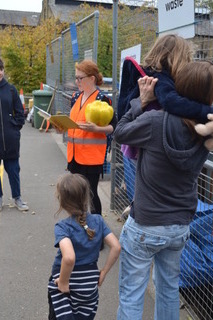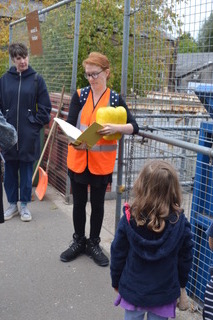I did my guided tour / performance-lecture yesterday afternoon to a crowd of people who had booked on via the Brighouse Arts Festival website, free. There was a nice mix of familiar art scene faces and new people as well – including one person I recognised from Rubbish Conversations at the centre previously. She seemed a bit embarrassed that I recognised her from the recycling centre “like I’m a regular there!” she joked. I may be shockingly bad at remembering names and how old I am but I can remember faces.
The weather held out as I made my introduction, toured the facility and did a mini quiz and then Q&A. I felt like I did a lot of reading from my script (whilst awkwardly juggling the yellow pepper) but people’s feedback has been great. Very interestingly people wondered whether the pepper would be thrown into the skip at the end in a finale act – but I am pretty attached to it now and it’ll probably feature in more work down the line…
The Q&A at the end was really good and I got a lot from that. Rubbish Conversations at their best!
My exhibition is up at Smith Art Gallery and Brighouse Library until the end of the month but I have A LOT of information and material to mentally process now. It’s been really intense but I’ve loved every minute of it.
I also hope the Suez site and area manager were serious when they were saying that I could come on site visits with them to some of the processing centres.
Here is my script:
Introduction
I introduced the tour talking about my residency process focussing on object histories, talking rubbish as practice and the value of rubbish in art practice, and the resultant exhibition at Smith Art Gallery and Brighouse Library.
My guided tour took us around the recycling centre briefly discussing each recyclable material and recycling process. I read a short except selected from Lots More Tell Me Why “Hundreds of Answers to Questions Children Ask” (1974) select for for each recyclable material.
We ended at the charity shop with a mini quiz and Q&A.
Rubble
Each household is allowed a maximum of 6 rubble sacks (of 20kg maximum capacity) per year. Most of this rubble is crushed and used as road base material.
p.39 What is a stalactite
Paper
Before it can be recycled, collected paper must be sorted and graded; there are over 50 grades of waste paper. The four main groups are:
-
Low grade – ie: mixed paper, corrugated board
-
De-inking grade – ie: newspapers, magazines, office paper
-
Kraft grade – ie: unbleached brown packaging
-
High grade – ie: printer cut-offs, unprinted paper
p.129 How did animals get their names
Cans
Aluminium and steel cans are separated by a huge magnet and the aluminium cans crushed into bales. They are then shredded and smelted and then made into rectangular shaped ingots ready to be rolled back into sheets of aluminium.
p.50 What doesn’t all coffee taste alike?
Gas bottles
Gas bottles are sorted and sent to suppliers to be refilled.
p.346 What makes a balloon rise?
Paint
This paint goes to New Reach in Bury which sells about 37,000 litres a year, using 5 or 6 base colours, which are then resold to companies like Dulux. Gloss paint is classified as hazardous but emulsion is not. Fence paint, such as creosote, is not taken here.
p.336 What are primary colours
Fridge Freezers
Fridges and freezers are taken to specialist recycling centre in Telford where they are deconstructed within a sealed environment so that any Ozone Depleting Substances can be safely removed. The remaining materials are separated mechanically into individual product streams including plastics, ferrous and non-ferrous metals and foam to be recycled or reused.
p.338 What makes hot and cold
TVs
TVs and monitors, known as e-waste, and are sent to specialist processing centre in Huddersfield to be broken down and precious metals recovered to be recycled.
p.384 How does a satellite transmit TV programmes
Textiles
The recycling charity Waste & Resources Action Programme (WRAP) estimate £140 million worth of clothing goes into landfill each year. These textiles are shipped out to be recycled in other countries.
p.183 How old is weaving?
Batteries
Batteries contain a variety of toxic heavy metals that are energy intensive to recycle. Some types of battery are less toxic and easier to recycle. The plastic is burned away at high temperatures and the metals smelted down to be made into new materials.
p.21 What is the corona of the sun?
Old Recycling Centre
This used to be the recycling centre when the land behind was the former tip.
The roof has gone and it’s considered semi-derelict.
Glass
Glass is taken to Glass UK in Barnsley where it is crushed, decontaminated and then melted at 1500°C to make new glass. When there is an excess in glass needed for production, it is used in tarmac.
p.156 When were spectacles invented?
Lightbulbs
Lightbulbs are processed and broken down into their constituent parts of: mercury, phosphor powder, glass, metals, cardboard and plastics, which are then recycled.
p.328 What does AM PM mean?
Oil
Although it gets dirty, used oil can still be cleaned and re-used as an industrial burner fuel, hydraulic oil, incorporated into other products or re-refined back into new lubricating oil.
p.123 Where were the first fossils found?
Plasterboard
Plasterboard contains gypsum, which is a sulphate, but classified as non-hazardous, however if sent to landfill it must be buried separately to biodegradable waste. It can also be recycled back into plasterboard.
p.372 How many kinds of nails are there?
Scrap metal
Scrap metal goes to the processing facility to be screened, decontaminated, sorted and baled ready to be smelted and made into sheet material.
p.72 How is aluminium foil made?
Electricals
Electrical items are broken down into fragments and sorted with vacuums and magnets into: Ferrous and non-ferrous metals, circuit boards, cables, batteries, cardboard and motors, which are then sent to be processed to reclaim and recycle the materials.
p.206 How does the brain store information?
Garden Waste
Garden waste is mainly turned into compost.
p.91 Why is the four-leaf clover lucky?
General Waste
When general waste is taken to be processed, a robotic machine sorts and picks out materials including glass, metal and cardboard to be recycled. The rest is separated into waste suitable to be burned for fuel and the rest for landfill.
p.225 How many odours can we smell?
Cardboard
Cardboard is shredded, pulped and filtered to remove decontaminates. It is then mixed with new material, dried and pressed into thin linerboard. These linerboards are then glued together to make new cardboard.
p.58 What is the tallest tree?
Wood
Wood is shredded, then compressed and glued into chipboard.
p.151 Who made the first table?
Recycling Centre
Items considered resellable are intercepted at the skips by the staff or taken directly to the recycling centre by customers where the staff assess it’s potential resale value.
Everything is weighed to contribute towards the total percentage recycling statistics this site is required to produce.
Mini Quiz
Q1: Which skip do trees go in?
A: Garden waste. Although it’s wood, it does not go into wood recycling.
Q2: Which skip do old filament bulbs go in?
A: General waste. Only new style bulbs can be recycled.
Q3: Which glass bin does blue glass go in?
A: Clear.
Q4: Which skip does empty paint go in?
A: General. Only paint tins with paint go in the paint recycling
Q5: Which recyclable material is the most valuable?
A: Cardboard or textiles depending on the recyclable materials stock market!
Q6: What material in light bulbs makes them classified as hazardous waste?
A: Mercury
Q7: What is the biggest hazard on site?
A: People (especially people in moving vehicles)
Q8: Which skip would a metal and electrical object go in?
A: Electrical – prioritised for the electrical component value. Processing strips the object down and sends metal to be recycled, whereas scrap metal processing cannot do this.

















